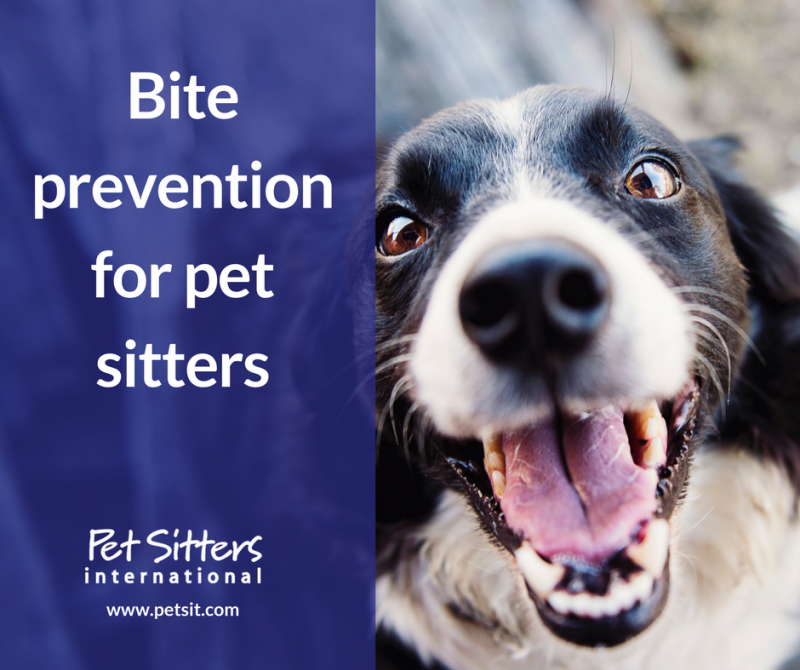Bite prevention for pet sitters
By Katenna Jones, ScM, ACAAB, CCBC, CDBC, CPDT-KA
Statistically, it’s only a matter of time before pet professionals are bitten. There are some who are proud of their bites, wearing scars like a badge of honor. Color me unimpressed. What DOES impress me, however, is someone knows how to read and accommodate pets, rather than forcing them into defending themselves. It is pet sitters who have the uniquely dangerous job of entering homes and interacting with pets without owners present. The good news is, with a few precautions, the risk of bites can be dramatically reduced.

Compile a thorough history and assessment.
Be sure to gather as much information as possible, and ask clear, specific questions prior to and during intake. For example: “Has your pet shown any type of aggression to any human or animal for any reason?,” “How does your pet respond to stressful situations, like storms, fireworks, parties, or anger?,” etc.
Recognize body language and respond appropriately.
All pets will warn before a bite, unless they have been punished for it in the past. For example, correcting a dog for growling does NOT make them no longer aggressive. Rather, it teaches pets that warnings get them in trouble and next time they won’t growl—they’ll go straight to the bite. Other cases where we have to be careful are when humans have removed an animal’s ability to effectively communicate, such as through selective breeding or surgery. It’s hard to tell if floppy or cropped ears are pinned back, or if the tail is high or tucked if there is no tail. Be sure to check out the body language resources PSI has available, including my webinar on behavior.
Pay attention and proceed appropriately.
Give pets a chance to communicate and assess your intentions. They are determining if you are safe, just as you are them. Pets who are stressed, afraid, elderly, or agitated change their minds quickly. Move slowly, predictably and know how to deescalate the situation. Avoid becoming distracted during conversations or rushing because you are running late. If a pet becomes aggressive, it is your job to address the situation appropriately.
Ask each pet for permission, each time.
Just because they allowed you to put their coat on last week, does not mean they are ok with it five months later. Perhaps they are ill, in pain, or simply overstimulated. You may have worked with 500 yellow labs, but the next one may be very different. I don’t know how often I hear “he was fine, and suddenly he snapped without warning!” In the vast majority of cases, the pet DID warn but the victim simply wasn’t paying attention (see #1 above!).
Walk safely.
Before walking a dog, familiarize yourself with the neighborhood and identify where problem areas may be. Be prepared to encounter a loose dog, always carry safety supplies, and ensure your dog is under control.
This article is my challenge to you to avoid bites. Of course, it’ll happen – but the fewer bites you have, the better you are!

Katenna Jones, ScM, ACAAB, CCBC, CDBC, CPDT-KA, provides private dog and cat behavior consulting services, group classes, and seminars at both local and national events through her business Jones Animal Behavior. She is an Associate Certified Applied Animal Behaviorist, Certified Cat and Dog Behavior Consultant, and Certified Pet Dog Trainer. She shares her RI home with her husband, two adopted cats, and adopted dog.







Comments
Dorothea (Dot) Roise-Lodsin
The World Veterinary Association describes appropriate aggression and non-appropriate aggression. Under the category of appropriate aggression is ritualized aggression. Dog bites from dangerous dogs fall under inappropriate aggression and may occur WITHOUT WARNING!!!
I am reading all I can find on dog aggression.
NOT ALL PETS WARN BEFORE THEY BITE!!!!!
This is a false and misleading statement.
Many years ago, I interviewed with an old client who had just adopted a new, young adult dog. The dog was sitting quietly in front of me while we talked. When I reached down to pet under his chin, he took my forearm in his mouth and held on. Determined to work through this, I met again with the owner, a dog trainer and the dog a week later. I let the dog out of his crate, he sat next to me , whle I slipped his collar over his head he took my other forearm into his mouth and held on. No snarling, no barking, no ears flattened, Ears were perked up, his mouth was slightly open and light panting. He sat quietly by me while he inflicted bloody wounds which left scars. Meanwhile, the trainer was yelling at me from the other side of the room not to bend over. The yelling did not help. In 25 years, I have managed 100's of dogs. This one and one other were new to the owner and gave no warning before tearing at my legs and arms. Even the World Veterinary Association defines the difference between appropriate aggression and inappropriate aggression. I urge you to take a look at this study because to assume all dogs give a warning is misleading and dangerous.
David Meak
Peggy
Kim
Lisa
Lisa
Jack
The second time the owner inadvertently (I hope) “set me up” at our first meeting. Their high strung young German Shepherd was reactive to the doorbell being rung but they failed to tell me in advance! (I declined to care for the dog a second time although I did complete the initial 5 day care assignment.)
The third time was an unlucky combination of events: the dog didn’t want to go out because it was raining. I had to pull him out the door onto a small landing 4 feet above the sidewalk. When he started snarling and snapping there just wasn’t enough room on the landing for me to prevent being bit.
Leslie